Lockheed SR-71 Blackbird is undoubtedly one of the most incredible planes ever made. This bird from the Cold War era was made to spy on Soviet military infrastructure and industry and could do that with unprecedented precision and speed. It even looks like a spaceship, even though it was designed back in 1950’s. But did you know it was leaking fuel all over the runway?
Lockheed SR-71 completed its maiden flight in 1964 and entered service in 1966. It was one of the first STEALTH aircraft in the world, which allowed it to sneak through radas of potential enemies of the U.S. The design of the SR-71 was based on the experimental Lockheed A-12 reconnaissance aircraft. But, of course, the most impressive Blackbird’s feature was its incredible hunger for speed.
Lockheed SR-71 Blackbird still holds the record of the fastest air-breathing manned aircraft ever made. At the altitude of 24 km it could reach 3,540 kph. It could climb to an altitude of 26 km. This allowed the Blackbird to outrun anti-aircraft missiles (ability that was tested in 1986 over Libya). But where there is speed, there is friction. Where there is friction, there is heat. And where is heat, there is metal expansion.

SR-71 had to be incredibly resistant to temperature, because it would really heat up on its reconnaissance missions. 85 % of the SR-71 was made from titanium (mostly sourced from the Soviet Union, by the way), the rest – from polymer composites. Titanium is quite resistant to heat, but additional measures had to be taken to make the entire plane stand up to the challenges of friction. For example, the top skin of the wings was corrugated, not smooth – this allowed for greater expansion. The outer windscreen of the cockpit, which would reach the temperatures of 316 °C during a mission, was made of quartz and was ultrasonically fused to the titanium frame.
Titanium fouselage panels were fitted to the frame relatively loosely – again, to allow for heat expansion. This is what caused those infamous fuel leaks – every single one of SR-71 ever made started leaking fuel at some point. But why?

Well, metals expand when heated and shrink when cooling down. The fuel system of the SR-71 could not be sealed permamently because there simply were no sealants that were flexible and durable enough to deal with those kind of temperatures and shrinking-expansion cycles. Sealants were applied and re-applied during maintenance (when they were fresh, the plane wasn’t leaking), but they simply wouldn’t hold up. SR-71 would stop leaking once it came up to temperature.
Also, fuel in SR-71 was used to cool the titanium surfaces. Because titanium pieces were fitted with some room for expansion and only came into good alignment when up to temperature during a high-speed flight, fuel was leaking through them.

It wasn’t that much of a problem, actually. Lockheed SR-71 Blackbird would leave a trail of the JP-7 aviation fuel on the runway, but the amount of fuel actually lost was insignificant compared to overall capacity. SR-71 could take up 46,255 litres of fuel, but it was rarely filled up before take-off.
Taking-off with less fuel was actually prefered, because it was safer (if one of the engines fails a lighter plane is better) and expanded the lifespan of the tires and brakes. This meant that SR-71 was looking for a tanker plane immediately after taking off. This strategy, by the way, was chosen not because of the fuel leaks.

Lockheed SR-71 Blackbird was finally retired from USAF service in 1998. In 1999 it retired from the NASA fleet as well. 12 SR-71s were lost over the 32 year career, but none of them were lost to enemy action.




